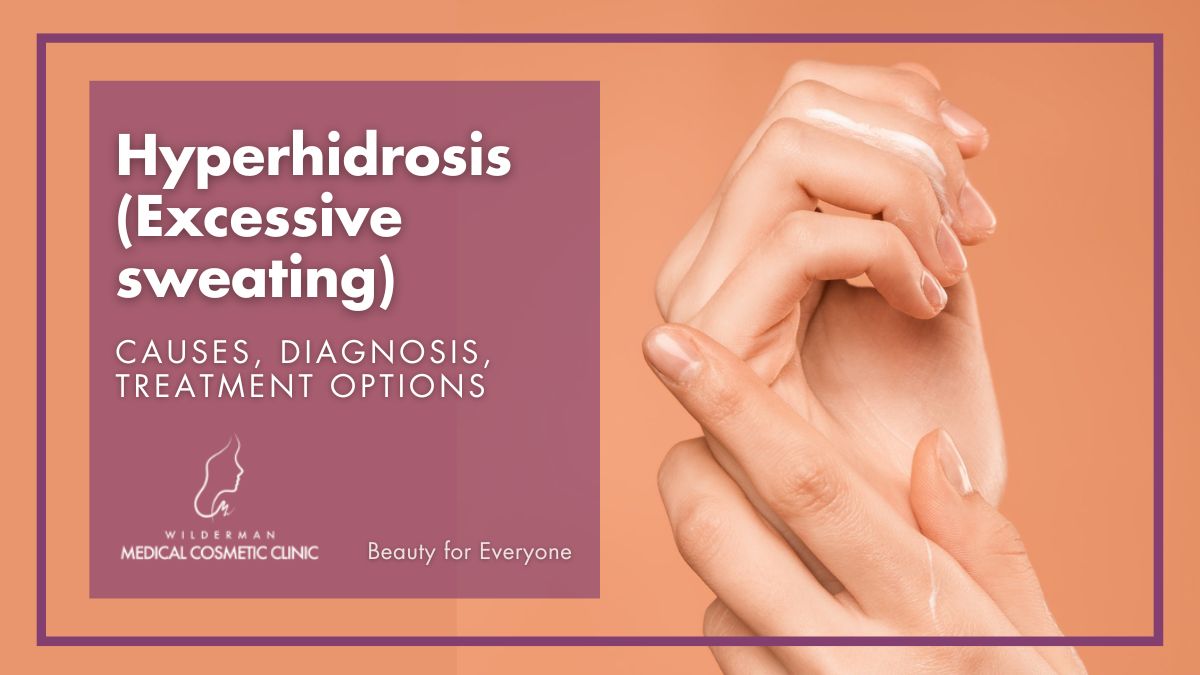Hyperhidrosis (Excessive sweating)
Causes, Diagnosis, Treatment Options
Excessive sweating, also known as hyperhidrosis, is a condition characterized by the production of abnormally high amounts of sweat.
While sweating is a natural bodily function that helps regulate body temperature, individuals with hyperhidrosis experience excessive sweating even when the body doesn’t require cooling.
This condition can significantly impact a person’s quality of life, causing embarrassment, discomfort, and emotional distress. In this article, we will explore hyperhidrosis in detail, including its types, causes, diagnosis, and available treatment options.

Get immediate answers about possible treatment options tailored for you, expected results, and much more.
- Expert Diagnosis
- Customized Treatment Plans
- No Obligation
- Comfort and Privacy
- Immediate Answers
Primary Hyperhidrosis vs. Secondary Hyperhidrosis
Hyperhidrosis can be classified into two main types: primary hyperhidrosis and secondary hyperhidrosis.
Primary Hyperhidrosis:
Primary hyperhidrosis refers to excessive sweating that occurs without an underlying medical condition or known cause. It often begins in childhood or adolescence and affects localized areas, such as the palms, soles of the feet, armpits, or face.
Primary hyperhidrosis is thought to be caused by overactive sweat glands and is believed to have a genetic component, as it often runs in families. The exact cause of primary hyperhidrosis is still not fully understood.
Secondary Hyperhidrosis:
Secondary hyperhidrosis is excessive sweating that occurs as a result of an underlying medical condition or external factor. This type of hyperhidrosis usually affects larger areas of the body and can occur suddenly later in life.
Medical conditions that can cause secondary hyperhidrosis include hormonal imbalances (such as menopause or hyperthyroidism), infections, certain medications, neurological disorders, and metabolic disorders. Treating the underlying condition often helps alleviate secondary hyperhidrosis.
Causes of Hyperhidrosis
The causes of primary hyperhidrosis remain largely unknown, although genetic factors are thought to play a role. Secondary hyperhidrosis, on the other hand, can be triggered by various factors, including:
- Medical Conditions: Certain medical conditions can trigger excessive sweating. These include hormonal imbalances (e.g., menopause, hyperthyroidism), diabetes, obesity, gout, infections (e.g., tuberculosis, HIV), certain cancers, cardiovascular diseases, respiratory disorders, and neurological disorders (e.g., Parkinson’s disease).
- Medications: Excessive sweating can be a side effect of certain medications. Examples include antidepressants, antipsychotics, hormonal drugs (e.g., hormone replacement therapy), some antibiotics, and medications for treating fever and pain.
- Substance Abuse: The use of certain substances, such as alcohol or illicit drugs, can lead to excessive sweating.
- Menopause: Menopausal women often experience hot flashes and night sweats due to hormonal changes, leading to temporary hyperhidrosis.
- Stress and Anxiety: Emotional stress, anxiety, and nervousness can trigger excessive sweating in some individuals.
- Hyperthyroidism: Overactive thyroid glands can cause increased metabolic activity, leading to excess sweating.
- Obesity: Being overweight can contribute to excessive sweating, as excess fat can act as insulation, raising the body’s core temperature.
- Spinal Cord Injuries: Damage or trauma to the spinal cord can disrupt the body’s temperature regulation, leading to excessive sweating.
It is essential to identify the underlying cause of hyperhidrosis to determine the most appropriate treatment approach. Consulting with a healthcare professional or aesthetic physician can help in diagnosing the cause of hyperhidrosis and developing an effective treatment plan.
Diagnosis
Diagnosing hyperhidrosis involves a thorough evaluation of a person’s medical history, physical examination, and sometimes additional tests. Here are the steps involved in diagnosing hyperhidrosis:
- Medical History: A physician will start by taking a detailed medical history, which includes asking about the individual’s symptoms, when they started, their frequency and severity, any triggering factors, and the impact on daily life. They will also inquire about any underlying medical conditions, medications being taken, any alcohol or recreational drug use, and family history of hyperhidrosis.
- Physical Examination: A physical examination will be conducted to assess the extent and distribution of sweating. The doctor will check for signs of sweating in specific areas, such as the palms, soles of the feet, armpits, or face. They may also evaluate for any underlying medical conditions that could be contributing to hyperhidrosis.
- Sweat Test: In some cases, a sweat test may be performed to measure the amount of sweat being produced. There are a few different types of sweat tests:
- Starch-Iodine Test: This test involves applying an iodine solution followed by starch powder to the skin. As the sweat interacts with the starch, it changes color, allowing the doctor to visualize and measure the extent of sweating.
- Paper Test: Special paper or sweat-indicating patches may be placed on the skin to absorb sweat. The paper is then weighed or analyzed to determine the volume of sweat produced.
- Additional Tests: Depending on the findings from the medical history, physical examination, and initial tests, further investigations may be required to identify any underlying causes or contributing factors. These additional tests may include blood tests, imaging studies (e.g., ultrasound, MRI), or referral to specialists for further evaluation.
It is important to note that the diagnosis of hyperhidrosis is typically based on the individual’s reported symptoms, medical history, and physical examination findings. In some cases, the cause may not be easily identifiable, and a diagnosis of primary hyperhidrosis may be made.
Treatment Options
Treatment options for excessive sweating depend on the severity and underlying cause of the condition. Here are some common treatment approaches:
- Antiperspirants: Over-the-counter or prescription-strength antiperspirants containing aluminum chloride are often the first line of treatment for mild to moderate hyperhidrosis. They can be applied to the affected areas, such as the underarms, hands, or feet, to reduce sweating. Antiperspirants work by temporarily blocking the sweat ducts.
- Medications: In cases where antiperspirants are ineffective, doctors may prescribe medications to help reduce sweating. It is important to note that medications may have potential side effects, and their use should be carefully monitored by a healthcare professional. These may include:
- Anticholinergic Drugs: Medications that block the chemical messenger acetylcholine, which stimulates sweat production, can be prescribed. Examples include glycopyrrolate and oxybutynin. These medications are more commonly used for generalized hyperhidrosis and may have side effects such as dry mouth, constipation, and blurred vision.
- Beta-Blockers: Certain beta-blockers, such as propranolol, can help reduce sweating, especially in situations triggered by anxiety or stress.
- Botulinum toxin Injections: Botulinum toxin (Botox) injections can be an effective treatment for focal hyperhidrosis, particularly in the underarms, palms, or soles of the feet. The toxin temporarily blocks the nerves that stimulate the sweat glands, reducing sweating in the treated area. The effects typically last for several months before retreatment is necessary.
- Iontophoresis: This procedure involves placing the affected areas, such as hands or feet, in the water while a low electrical current is applied. The electrical current temporarily blocks the sweat glands. Regular sessions are required initially, followed by maintenance treatments to manage symptoms.
- Microwave therapy: This non-surgical procedure utilizes microwave energy delivered through a specialized device to selectively heat and eliminate the sweat glands in the affected area.
- Surgical Interventions: In severe cases of hyperhidrosis that do not respond to other treatments, surgical options may be considered. These procedures are typically a last resort due to associated risks and potential complications. Surgical interventions for hyperhidrosis include:
- Sweat Gland Removal (Curettage): This surgical procedure involves the removal of sweat glands in the affected areas. It is typically used for treating excessive underarm sweating.
- Nerve Surgery (Sympathectomy): In certain cases, a surgical procedure called sympathectomy may be performed. It involves cutting or clamping the nerves responsible for sweating. Sympathectomy is typically reserved for severe cases of hyperhidrosis that have not responded to other treatments.
- Lifestyle Modifications: Certain lifestyle changes can help manage hyperhidrosis symptoms. These include:
- Wearing breathable fabrics and loose clothing to allow better air circulation.
- Using absorbent materials, such as shoe inserts or sweat-absorbing pads, to minimize sweat accumulation.
- Practicing good hygiene, including daily showers and keeping the affected areas clean and dry.
- Avoiding triggers such as spicy foods, caffeine, and alcohol that can exacerbate sweating.
- Managing stress through relaxation techniques, counseling, or stress management strategies.
It is important to consult with a healthcare professional or aesthetic physician to determine the most suitable treatment options based on individual circumstances and the severity of the condition. They can provide guidance on the most appropriate treatments and help manage hyperhidrosis effectively.
Conclusion
Excessive sweating, or hyperhidrosis, can significantly impact an individual’s quality of life, causing discomfort and emotional distress. While primary hyperhidrosis often occurs without an underlying cause, secondary hyperhidrosis is typically the result of an underlying medical condition.
The diagnosis of hyperhidrosis involves evaluating medical history, physical examination, and sometimes additional tests. Treatment options include antiperspirants, medications, botulinum toxin injections, iontophoresis, surgery, and lifestyle modifications.
By working closely with healthcare professionals, individuals with hyperhidrosis can find relief and improve their overall well-being.
Reference
Schlereth T, Dieterich M, Birklein F. Hyperhidrosis–causes and treatment of enhanced sweating. DtschArztebl Int. 2009 Jan;106(3):32-7. doi: 10.3238/arztebl.2009.0032. Epub 2009 Jan 16. PMID: 19564960; PMCID: PMC2695293.
Brackenrich J, Fagg C. Hyperhidrosis. In: StatPearls [Internet]. Treasure Island (FL): StatPearls Publishing; 2023 Jan-. Available from: https://www.ncbi.nlm.nih.gov/books/NBK459227/. Accessed June 7, 2023.
Mayo Clinic. Hyperhidrosis. Mayo Clinicwebsite. Available from: https://www.mayoclinic.org/diseases-conditions/hyperhidrosis/symptoms-causes/syc-20367152. Accessed June 7, 2023.
Cleveland Clinic. Hyperhidrosis. Cleveland Clinic website. Available from: https://my.clevelandclinic.org/health/diseases/17113-hyperhidrosis. Accessed June 7, 2023.
Johns Hopkins Medicine. Excessive Sweating. Johns Hopkins Medicine website. Available from: https://www.hopkinsmedicine.org/health/conditions-and-diseases/excessive-sweating. Accessed June 7, 2023.
NHS Inform. Hyperhidrosis. NHS Inform website. Available from: https://www.nhsinform.scot/illnesses-and-conditions/skin-hair-and-nails/hyperhidrosis. Accessed June 7, 2023.
Other skin conditions that may be of interest
Skin Laxity: A common skin concern – Skin laxity is a common concern that many individuals experience as they age. It is characterized by a loss of firmness, elasticity, and resilience in the skin, leading to a less …
Sagging Skin – As we age, one of the most common concerns we face is sagging skin. The loss of elasticity and firmness can affect various parts of our body, including the face, neck, arms, and abdomen. Sagging skin can be attributed to …
Stretch Marks: Causes, Treatments, Prevention – Stretch marks, also known as striae, are a common skin condition that affects both men and women. They often appear as visible lines on the skin, typically on …
Spider Veins and Broken Capillaries – Spider veins and broken capillaries are common vascular conditions that affect a significant number of people. While they are typically harmless, they can cause cosmetic concerns for …
Oily Skin – Oily skin is a common dermatological condition characterized by excess sebum production, which can lead to a shiny, greasy appearance and potential skin issues such as acne breakouts and clogged pores. While it can be …
Smoker’s lines: A real connection to smoking? – Smoker’s lines, also known as lip lines, lipstick lines, or perioral wrinkles, are fine lines that develop around the mouth and lips. These lines can be unsightly and may contribute to …
Acne Scarring: Causes, Treatment, Prevention – Acne is a common skin condition that affects millions of people worldwide, causing physical and emotional distress. In some cases, acne can leave behind unsightly scars, further impacting …
Dark Under-Eye Circles – Dark under-eye circles can be frustrating and make you appear tired or older than you actually are. They are a common cosmetic concern that affects people of all ages. We will explore what …
Stay Ahead of the Beauty Curve
Beyond Beauty: Elevate Your Routine with Insider Tips and Breakthroughs – Subscribe Now!
Transform your beauty routine into something extraordinary!


